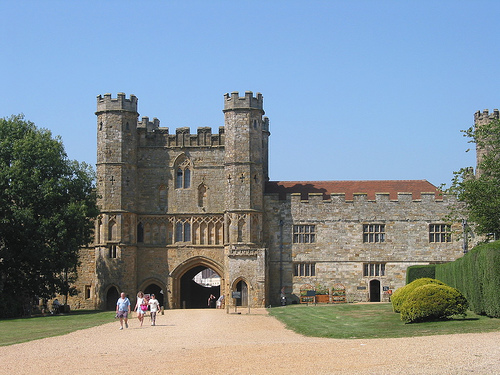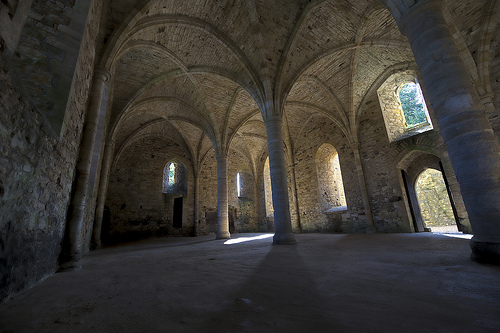

Location: High St., Battle Map
Found: 1070
Dedicated to: St. Martin
Tel. 01424 775705
Open: Easter- Sep: 10am- 6pm daily
Oct- Easter: 10am- 4pm daily
Closed: 1 Jan, 24- 26 Dec
Official site
Reenactment sites:
Battle Abbey, located in the town of Battle, East Sussex, England, is a historic site of immense significance, primarily known for its association with the Battle of Hastings in 1066. Founded by William the Conqueror, the abbey is a partially ruined Benedictine monastery that stands as a testament to one of the most pivotal moments in English history. Below is an in-depth exploration of Battle Abbey, covering its history, architecture, cultural significance, and modern-day context.

Battle Abbey was established to commemorate William the
Conqueror’s victory at the Battle of Hastings on October 14, 1066, a
decisive event in the Norman Conquest of England. According to
tradition, William vowed to build an abbey on the site of the battle
if he won, as a gesture of thanksgiving and penance for the
bloodshed. The abbey was dedicated to St. Martin of Tours and
constructed between 1070 and 1094, with its high altar reputedly
placed on the exact spot where King Harold II fell during the
battle.
The abbey was not only a religious institution but also a
symbol of Norman authority, reinforcing William’s claim to the
English throne. It was endowed with significant lands and wealth,
making it one of the richest monasteries in medieval England. Over
the centuries, the abbey played a central role in the religious,
political, and social life of the region until its dissolution in
1538 during the reign of Henry VIII.
Battle Abbey’s architecture reflects its medieval origins, though
much of the original structure has been altered or destroyed over time.
The surviving elements provide a glimpse into its grandeur and the
evolving architectural styles of the period.
The Abbey Church:
The original abbey church, completed around 1094, was a grand Norman
structure, though little of it remains today. It was designed in the
Romanesque style, characterized by rounded arches, thick walls, and
robust stonework.
The high altar, as mentioned, was symbolically
placed where Harold fell, though the exact location is debated among
historians.
The church was largely demolished after the Dissolution
of the Monasteries, and only fragments, such as parts of the
foundations, remain visible.
The Gatehouse:
The most striking
surviving feature of Battle Abbey is its imposing 14th-century
gatehouse, a masterpiece of medieval military architecture. Built around
1338, it served both defensive and ceremonial purposes.
The gatehouse
features twin octagonal towers, battlements, and intricate stonework,
reflecting the Gothic style of the period. It is one of the
best-preserved parts of the abbey and a prominent landmark in the town
of Battle.
The Monastic Buildings:
The abbey’s monastic
complex included a cloister, chapter house, refectory, and dormitories
for the monks. The 13th-century dormitory range, known as the “Great
Guest House,” is particularly notable and partially survives.
The
undercroft of the guest house, with its ribbed vaulting, is a fine
example of Gothic architecture and offers insight into the abbey’s role
in hosting pilgrims and visitors.
The Battlefield:
The abbey
is situated on the battlefield itself, which adds to its historical
resonance. The terrain, with its gentle slopes and open fields, has been
preserved to reflect the landscape of 1066, though some modifications
have occurred over time.
Visitors can walk the battlefield, guided by
paths and markers that outline the key events of the Battle of Hastings,
such as the Norman advance and the Anglo-Saxon shield wall.
Battle Abbey’s history can be divided into several key phases:
Foundation and Medieval Period (1070–1538):
After its founding,
the abbey became a thriving Benedictine monastery, housing monks who
followed the Rule of St. Benedict. It was a center of learning, prayer,
and administration, overseeing extensive estates across southeast
England.
The abbey’s wealth and influence grew, but it also faced
challenges, including a fire in the 12th century and periodic tensions
with local authorities.
By the 14th century, the abbey was fortified,
reflecting the turbulent times of the Hundred Years’ War and the need to
protect its wealth.
Dissolution and Decline (1538–19th Century):
In 1538, during Henry VIII’s Dissolution of the Monasteries, Battle
Abbey was surrendered to the crown. The monastic community was
disbanded, and the abbey’s lands and treasures were seized.
The site
was granted to Sir Anthony Browne, a courtier of Henry VIII, who
converted parts of the abbey into a private residence. The abbey church
was largely demolished, and the remaining buildings were repurposed or
left to decay.
Over the centuries, the estate passed through various
owners, including the Webster family, who owned it from the 18th century
onward.
Modern Era (19th Century–Present):
In the 19th
century, interest in the historical significance of Battle Abbey grew,
spurred by the Romantic movement and a fascination with medieval
history. The site was partially restored and opened to visitors.
In
1976, the abbey and battlefield were acquired by the state and placed
under the care of English Heritage, which continues to manage the site
today.
Today, Battle Abbey is a major heritage site, attracting
visitors for its historical importance, architectural beauty, and
connection to the Norman Conquest.
Battle Abbey holds a unique place in English history for several
reasons:
The Battle of Hastings:
The abbey is inextricably
linked to the Battle of Hastings, a turning point that reshaped
England’s political, cultural, and social landscape. The Norman victory
introduced feudalism, transformed the English language (with the influx
of French vocabulary), and established a new ruling elite.
The
battlefield, preserved around the abbey, allows visitors to engage
directly with this history, walking the ground where the fate of England
was decided.
Symbol of Norman Power:
The abbey’s construction
was a deliberate act of Norman propaganda, asserting William’s divine
right to rule. Its grandeur and strategic location underscored the
permanence of Norman authority.
Religious and Social Role:
As
a Benedictine monastery, Battle Abbey was a spiritual and economic hub,
supporting the local community and pilgrims. Its wealth and influence
made it a key player in medieval Sussex.
Legacy and Preservation:
The abbey’s survival, even in partial ruin, reflects its enduring
importance. English Heritage’s stewardship ensures that the site remains
accessible, with ongoing efforts to preserve the ruins and educate the
public about 1066.
Today, Battle Abbey is a popular tourist destination managed by
English Heritage. Key features for visitors include:
Visitor
Experience:
The Abbey Ruins: Visitors can explore the gatehouse,
dormitory range, and other surviving structures, with informative
displays about monastic life and the abbey’s history.
The
Battlefield: A marked trail guides visitors through the battlefield,
with audio tours and signage explaining the tactics and events of
October 14, 1066.
Visitor Centre: The centre offers interactive
exhibits, including a film about the Battle of Hastings, artifacts, and
replicas of Norman and Anglo-Saxon weapons and armor.
Events: English
Heritage hosts regular reenactments, particularly around the anniversary
of the battle, featuring living history displays, mock battles, and
educational talks.
The Town of Battle:
The town grew around
the abbey and retains a historic charm, with Georgian buildings, quaint
shops, and pubs. The abbey remains the centerpiece of the town’s
identity.
Nearby attractions include the Battle Museum of Local
History, which complements the abbey’s exhibits with local artifacts and
stories.
Conservation Efforts:
English Heritage maintains the
site, balancing preservation with public access. Archaeological
investigations continue to uncover new insights about the abbey and
battlefield.
The site is part of a broader effort to protect
England’s medieval heritage, with ongoing debates about the precise
layout of the battlefield due to changes in the landscape over time.
The Legend of the Altar: The tradition that the abbey’s high altar
was built on the spot where Harold died is a powerful story, though some
historians question its accuracy, as the exact location of Harold’s
death is uncertain.
The Battle Abbey Roll: A supposed list of Norman
knights who fought at Hastings was kept at the abbey, though the
surviving versions are likely later fabrications. The roll remains a
subject of historical fascination.
The Curse of Battle Abbey:
According to legend, William the Conqueror cursed anyone who desecrated
the abbey. This tale was linked to Sir Anthony Browne, who reportedly
suffered misfortune after dismantling parts of the abbey.
Archaeological Discoveries: Excavations in the 20th century uncovered
evidence of the abbey’s wealth, including fine stonework and artifacts
from the monastic period.
Location: High Street, Battle, East Sussex, TN33 0AE, England.
Access: The site is easily accessible by car or train, with Battle
railway station a short walk away. It’s approximately 55 miles southeast
of London.
Opening Hours: Typically open daily from 10 AM to 5 PM,
though hours vary seasonally. Check English Heritage’s website for
current details.
Admission: Entry fees apply, with discounts for
English Heritage members. As of my knowledge cutoff, adult tickets are
around £12–£15, but prices may have changed (visit
https://www.english-heritage.org.uk/visit/places/battle-abbey for
up-to-date information).
Facilities: The site includes a café, gift
shop, and accessible paths for exploring the battlefield. Guided tours
and audio guides are available.